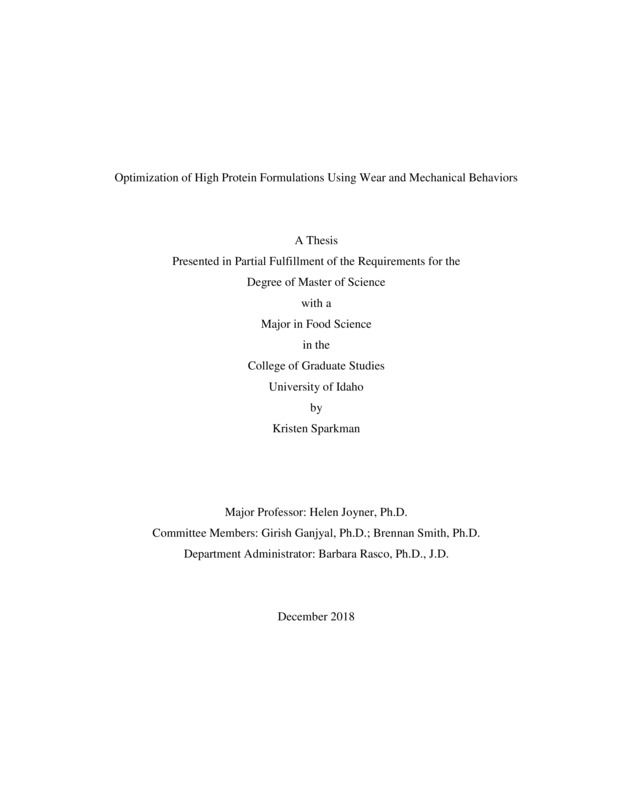Optimization of High Protein Formulations Using Wear and Mechanical Behaviors
Sparkman, Kristen. (2018-12). Optimization of High Protein Formulations Using Wear and Mechanical Behaviors. Theses and Dissertations Collection, University of Idaho Library Digital Collections. https://www.lib.uidaho.edu/digital/etd/items/sparkman_idaho_0089n_11498.html
- Title:
- Optimization of High Protein Formulations Using Wear and Mechanical Behaviors
- Author:
- Sparkman, Kristen
- Date:
- 2018-12
- Keywords:
- protien bars Rheology Tribology Wear
- Program:
- Interdisciplinary Studies
- Subject Category:
- Food science
- Abstract:
-
High protein bars are popular snack items that can have significant processing issues like sticking, clogging, and cold flow. These issues are primarily problematic during formulation development as current predictive testing is reliant on empirical bench tests or pilot plant testing that is expensive and time-consuming. Due to the deformation and thus structural information that rheological testing provides, it has promise to predict high protein bar processing ability. Wear testing, which has been used in the medical field to evaluate the lifetime of soft materials used in joint replacements, may have promise in evaluating food processing ability. The objectives of this study were to determine how ingredients impact formulation processing ability, determine potential predictive bench-level testing that would give information about formulation and thus processing ability, and create predictive models for high protein bar formulations based on empirical testing and instrumental data. Two response surface designs of model high protein bars comprising whey protein isolate (WPI), high fructose corn syrup (HFCS), and either canola oil or vegetable shortening were evaluated. Rheological tests including adhesion, strain and frequency sweeps, large amplitude oscillatory shear, and wear testing were conducted to determine the impact of individual ingredients on protein bar behavior. Ingredient formulation impacted the processing ability, wear testing, and rheological behaviors. Formulations with high ratios of WPI to HFCS and either shortening or oil exhibited good processing ability, lower wear rates, and increased elastic-type behavior, indicating that both bar rheological behaviors and processing ability is related to formulation. The predictive models had relatively high accuracy rates (> 85%) with only three misclassifications out of 20 samples seen for each of the oil and shortening formulations. The misclassifications created grey areas of predictive values for ingredient levels; more samples would increase model accuracy. Model validation testing showed that cold flow was best for predicting processing ability of oil formulations. For shortening formulations, wear rate and G'3/G'1 at 4% strain and 10 rad/s best-predicted processing ability. These models provide valuable information about ingredient ranges and tests that could be used to assist in the determination of processing ability.
- Description:
- masters, M.S., Interdisciplinary Studies -- University of Idaho - College of Graduate Studies, 2018-12
- Major Professor:
- Joyner, Helen S
- Committee:
- Ganjyal, Girish; Smith, Brennan
- Defense Date:
- 2018-12
- Identifier:
- Sparkman_idaho_0089N_11498
- Type:
- Text
- Format Original:
- Format:
- application/pdf
- Rights:
- In Copyright - Educational Use Permitted. For more information, please contact University of Idaho Library Special Collections and Archives Department at libspec@uidaho.edu.
- Standardized Rights:
- http://rightsstatements.org/vocab/InC-EDU/1.0/

